Archives
now browsing by author
The End
Today I am still scrambling to get my report finished and several groups are still working on finishing up their final projects. This has been such a great experience for the student and me. We have learned so much. There are many things I will do the same in future and there are definitely somethings I would change or plan for better. Time was an issue, so I will start sooner next time. Building independence in the students is something I can streamline a bit too with some more modeling and pre-loading. A highlight for me was watching what happened when I released control and handed the reigns over to the students. It was amazing to see what they are capable of and how interested they are in the topics they chose. A big wish was to have more opportunity for students to collaborate with members of the T’Sou-ke Nation, but it was difficult to get in touch with people as everyone is so busy.
Thank you sincerely for the opportunity.
Lisa
What is our road-map for our SET-BC Project Outcome Report? Where are we at in developing our final report? If there are digital samples, artifacts, displays, consider creating links on your blog.
After speaking with Monica during out check-in phone call, my plan is to use a slide show for my Project Outcome Report. The table of contents will basically follow the SET-BC list of requirements for the final report. The blog posts we have been keeping along the way will be a useful resource for writing the report. I plan to include some links to student projects and any other artifacts that I may find useful. If time permits, I would like to include some video of students speaking about the experience. I’m not sure if a slide show with videos will be too large to upload. I can make it using the slide app on Google Drive. That way, I can share the link to the slide show rather than uploading. Is this a possibility?
Feeling excited and a little panicked.
It is really hard to believe we are already in mid-April. I am really happy with how much information the kids have gathered as part of their inquiry projects. We are ready to take that information and create our presentations. Some students have already begun, and others are just waiting for the go ahead. I took some time last week, to have the kids pull out their inquiry questions and check on how they are doing answering those questions. Our goal from here on out is to decide how to present the research and then to make those presentations. One group has planned to build a watershed model, others are using technology to create Explain Everything presentations, slide shows, and iMovies. It is going to be a busy, but exciting time! Hope everyone else’s projects are going well!
Lisa
QR Codes
Hi again,
Just a quick post to provide you with a couple of links regarding QR codes. These are codes that can be scanned with a smart phone or tablet and will link to an audio clip, photo, website, video, etc. The students in my class that are using QR codes are saving voice notes and links to their Google Drives. We are just starting to play with these. If you look in the student draft presentation that I’ve included in my Artifacts post, you will see the kids have included some QR codes that link to documents they have written. Below are some links to QR how to’s that I found useful:
Artifact
An artifact (video, lesson plan, student work) that demonstrates the learning happening in your project.
Below I have attached a student sample of the inquiry planning package:
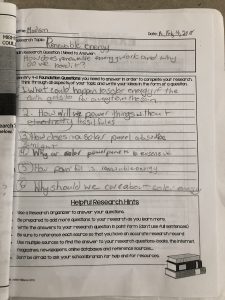
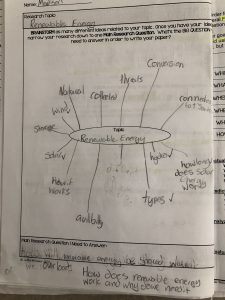
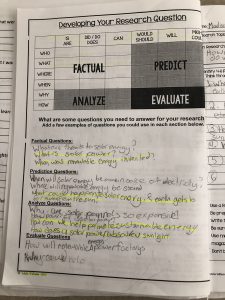

Here is a link to the draft presentation using slide show software and some drawing options:
This presentation is just getting started. Students plan to use iMovie to make a film to add in to the slide show as well as some of the music creating apps.
Some students are going to incorporate the drum making process into their larger inquiry projects as the drums represent our local First Nation, T’Sou-ke Nation, and the art work weaves in local animals and legends:
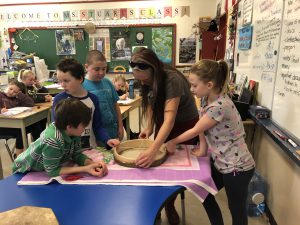

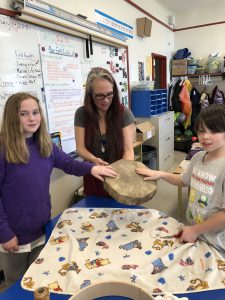
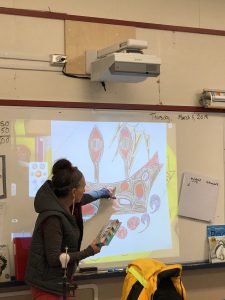


Assessment
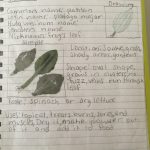
What is our approach to assessment in this project?
How are we assessing the work we and/or our students are creating with the project tools?
How are we assessing whether the project, the tools have been effective?
Assessment is tricky when working on a long term project that is multi-curricular. Sometimes it’s hard to decide what specifically to assess for. By this I mean, am I really going to pay attention to correct spelling, grammar, etc. or am I more interested in the process and connections to subject areas like science and social studies? Is it most important to pay attention to organizations and social development skills, or to the ability to edit and self-assess? Then there are the elements of design (ADST), art and technology skills that also need to be considered.
There are pieces of these types of projects that are more difficult to assess than others. For example, this week we had a mentor from T’Sou-ke Nation work with the kids to design drums to be gifted to the school. My class is grade 5, so the kids will be moving on to middle school next year and they want to leave something to say thank you and good by. I was gifted with a hide at the beginning of the year, so the kids have been involved in all the drum making steps, from cutting and soaking the hide to choosing the designs and painting the drums (we have only gotten to the pulling and drying stage so far plus the children have chosen the designs). During the whole process, the Elder talked to the kids about the masculine and feminine elements that we all carry (one drum is masculine and one is feminine) and the importance of keeping a good mind, heart, hands, eyes and ears while working with drum. Topics like honouring the animal and tree that the drum materials came from and the importance of using all parts were regularly reinforced. The lessons were so important and the students were fully engaged. What does assessment for this type of processes look like?


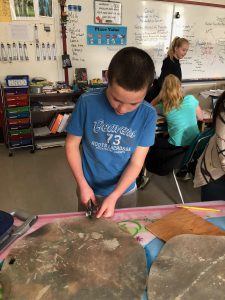

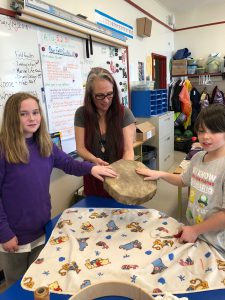
The lessons learned working as a group and from the Elder, as well as their thoughts and feelings throughout the drum making activities are what I want the students to remember. In order to do so, their was lots of time for discussion and reflection. My assessment will involve my observations and notes. In addition, all students have a field guide that they complete in their own style each time we have classroom guests or take part in an off site field study. The criteria and expectations for the field guides are clear, but students choose how they would like to document their learning (art, fun facts, songs, poems, paragraphs, etc.). I can post a photo of the field guide criteria in the resources section. For this particular activity, field guides would be assessed for basic language arts skills, but the emphasis would be on Aboriginal content in science and social studies. There are many other learning standards that are addressed in rich, experiential activities like these.
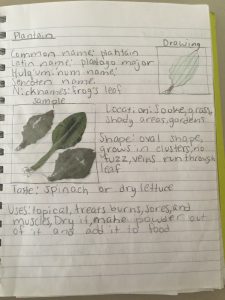
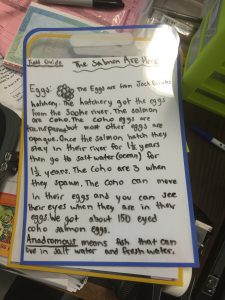
For my students, I want to see that they fully understand their topic and that by going through the processes involved in designing, organizing, researching and producing their projects, they have connected with their topic and see the relevance and importance of it to them as individuals and to their families and community.
I think the great thing about a project like this is that it does lend itself to assessment across the curriculum. You can also quite easily get overwhelmed and confused about what to assess. I am thankful for this month’s blog questions because they have helped me to clear up some of my own personal questions about what I am really looking for the kids to take from this project.
In order to see that students have spent time collaborating and organizing their research questions, I will use their completed inquiry/research packages that I mentioned last blog and have listed in the resources section. To help with assessment of their completed projects, I will refer to the criteria package that the students and I developed for the project. This package discusses the possible products students can create to share their learning; some are required and some are optional. This document is a work in progress. I have included one example of the criteria packages in the resources section.
I’m not sure that I have covered all 3 questions for this blog, but I am happy to be thinking more deeply about assessment for this project. I look forward to see everyone else’s posts too!
What software and/or apps and extensions have we used/explored for this project? Are there any useful tips that we can share with the teams or usage/troubleshooting tips that we have identified?
Hi Everyone,
Hope your projects are going well!
To answer the first questions for this blog, we haven’t really started using any of the software or apps to create our projects yet, because we are still mapping out project plans and developing inquiry questions. To do this, our kids are using a variety of sources like websites, books, videos, brochures, discussion with each other and with people knowledgeable on their topic.
We use google classroom to post templates, criteria and resources to help with their research. The students keep most of their project data and work in their google drives which is very handy because they can access their work from school or home and it doesn’t matter which classroom device they use because their files are associated with their login, not with one Chromebook or iPad.
A couple of discoveries I have made along the way are a good search resource for kids:
http://gws.ala.org/category/sciences
And, a great site for purchasing cheap second hand books, both fiction and non-fiction:
thriftbooks.com
I spent a bit of money on non-fiction books, but I got a lot more for my money than I would on Amazon or Scholastic.
Still on the lookout for videos and tutorials on some of the apps we received.
Lisa
Happy New Year!
Happy New Year to you all! I’m feeling recharged after the break and ready to jump into our project. Before the break, we kind of bit off more than we could chew. As I previously mentioned, the kids are very enthusiastic about their topics and have some very broad plans and ideas.
Over the break, I did some of my own research on teaching kids how to be researchers and found some very helpful resources that I am using to guide the kids with their projects. I will list these resources in my resources section. We have been slowing things down and looking more closely at what research is, why we research, how research can look, and what tools we can use.
This week we are going to dig a little deeper into why they have chosen their topics, and what it is that they want to learn and share. They have already begun by listing what they know, how they can verify what they know and what questions they have about their topics. If they are working in pairs or groups, they have meet with their partner(s) to highlight the important information that they already know and the most important questions they have. They will use this information to decide what they want to include in their projects and what research questions they will be exploring.
They are being very patient with me because they just want to get at it, but I’ve promised them that right now it’s mostly about me, but as we work together to clarify their research goals and products, I will be handing the reigns over to them.
I would love to hear of any inquiry or research resources you know of and if you have any suggestions. I’m also very interested hearing about any tutorials for some of the iPad apps that you would recommend.
Thanks
Lisa
Great Books, Websites and General Resources
RESEARCH & INQUIRY
- Research & Inquiry, Graphic Organizers to help students do a Research or Inquiry Project for ANY Subject, Grade 5-10, by Addie Williams (TpT)
- Scholastic, Teaching Students to Conduct Short Research Projects, by Ryan K. Gilpin (book)
- POL Student Lesson Criteria
BOOKS
- thriftbooks.com, affordable used books
KID FRIENDLY WEB SITES
Project Update – Getting started and where we are:
It is pretty early days but the ball is definitely rolling. The kids have all chosen partners and broad topics (e.g. marine studies, plants and their uses, local animals, sustainable energy, etc.) for their projects. They are very excited to get started! My biggest struggle right now is holding them back and helping them pair down some of their grand ideas. We are working on pre-planning and setting achievable goals. To help with this, I have created a slideshow to guide topic choices, product choices; it also identifies criteria, questions to think over and expectations. The kids are being good sports about going through this process, but I can tell they can’t wait until I let them loose. I have given them some freedom to start working and researching which has been useful in helping them figure out where they need to spend more time planning. Some of the questions they have to consider as they design their projects are:
- Why have you chosen this topic?
- What do you want others to learn from your project?
- How are you going to present your information/project?
- How does you project connect to Coast Salish culture and ways of being?
- Who can you speak to or interview to get some expert information on your topic?
- Does the topic of your project have any problems that need to be solved or face any threats?
- If so, what are some solutions or changes that we can make?
Our next steps will include team meetings to fine tune their projects and to work on creating a step by step plan that divides up responsibilities between team members. I have planning guides with checklists, criteria, ideas and suggestions for each team. I am happy to share these if anyone is interested in seeing them.
The iPads and Apple Pencils are huge hits! I have a few kids testing out some of the possible apps the class will be using to create projects. These “student experts” will share their tech knowledge with the rest of the class in combination with some mini lessons I plan and present.
Now that I know all the topic choices, I am on the look out for free and cheap resources and materials. We have enough to keep us busy for awhile, but if anyone knows of some good second hand books sites or places to buy building materials for solar projects, etc. please let me know. I will add any I find to my resources section.
In the new year, the plan is to starting connecting students with experts. I’m pretty excited to see who they would like to contact to interview and what types of questions they come up with.
That’s it for now. Happy Holidays everyone!
Lisa
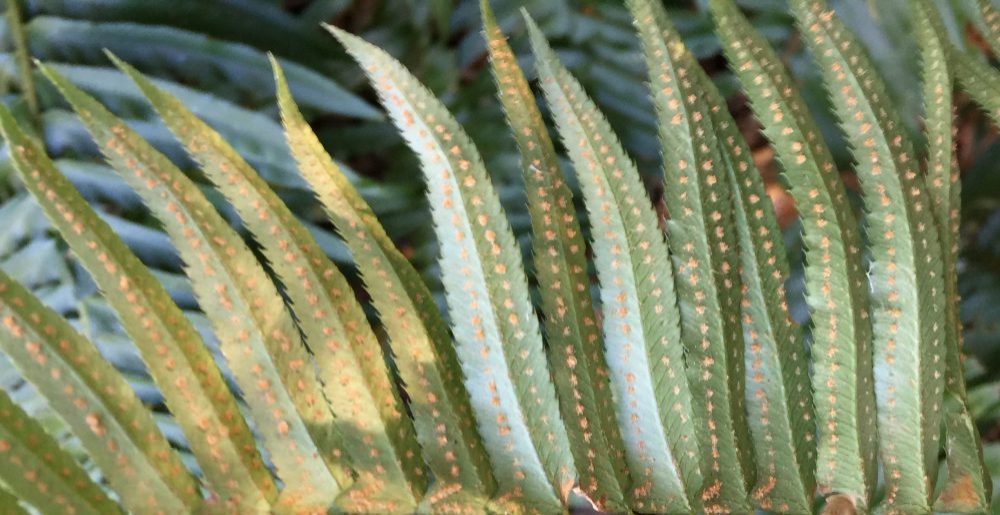
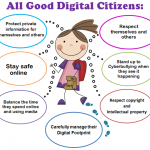
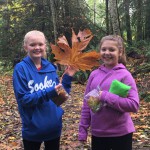
 D5 Creation
D5 Creation